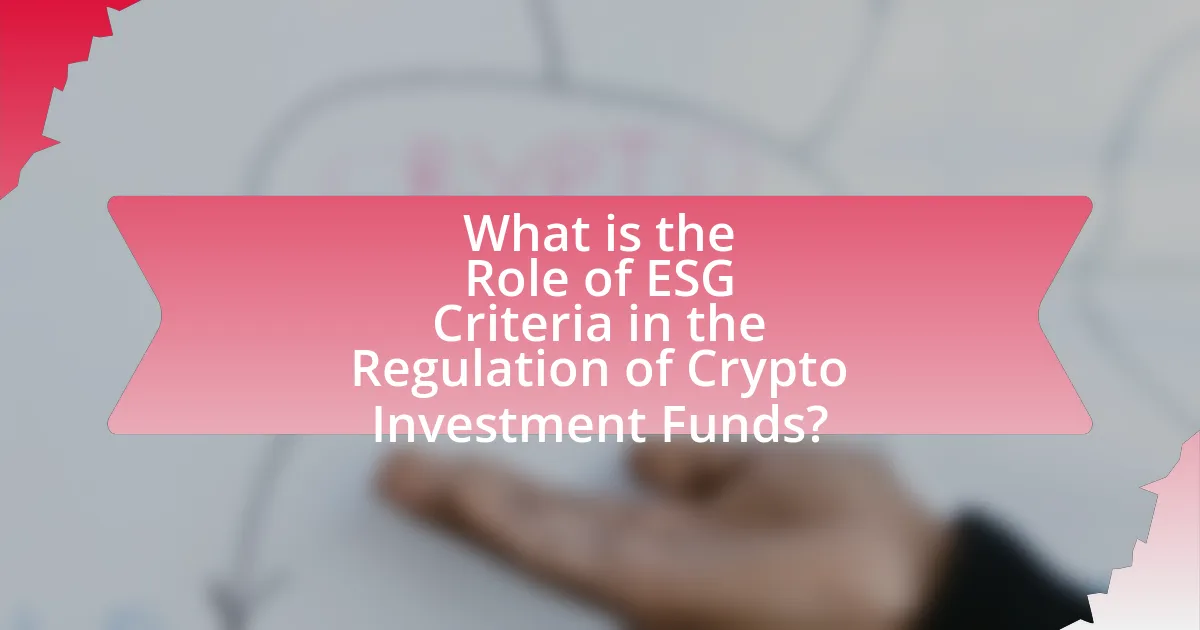ESG criteria, which encompass Environmental, Social, and Governance factors, are increasingly vital in the regulation of crypto investment funds. This article examines the significance of ESG criteria in assessing the sustainability and ethical impact of investments, highlighting their influence on investment decisions and the challenges investors face in integrating these factors. It also explores the regulatory frameworks governing crypto funds, the role of financial authorities, and the implications of ESG-focused regulations for investors. Additionally, the article discusses best practices for crypto funds to enhance ESG compliance and the resources available to improve their adherence to these standards.

What are ESG Criteria and Their Importance in Investment?
ESG criteria refer to Environmental, Social, and Governance factors that investors use to evaluate the sustainability and ethical impact of an investment. These criteria are important in investment as they help assess risks and opportunities related to environmental stewardship, social responsibility, and corporate governance practices. For instance, a study by MSCI found that companies with strong ESG performance tend to have lower capital costs and better operational performance, indicating that integrating ESG factors can lead to more informed investment decisions and potentially higher returns.
How do ESG Criteria influence investment decisions?
ESG criteria significantly influence investment decisions by guiding investors to consider environmental, social, and governance factors alongside traditional financial metrics. Investors increasingly prioritize companies that demonstrate sustainable practices, ethical governance, and social responsibility, as these factors are linked to long-term financial performance. For instance, a study by MSCI found that companies with strong ESG ratings often exhibit lower capital costs and better operational performance, leading to enhanced shareholder value. This trend is evident in the growing number of investment funds that incorporate ESG criteria, reflecting a shift towards responsible investing that aligns with societal values and investor expectations.
What are the key components of ESG Criteria?
The key components of ESG Criteria are Environmental, Social, and Governance factors. Environmental criteria assess a company’s impact on the planet, including carbon emissions and resource usage. Social criteria evaluate how a company manages relationships with employees, suppliers, customers, and communities, focusing on labor practices and community engagement. Governance criteria examine a company’s leadership, executive pay, audits, internal controls, and shareholder rights. These components are essential for investors seeking to understand the sustainability and ethical impact of their investments, particularly in sectors like crypto, where regulatory scrutiny is increasing.
Why are ESG Criteria becoming essential for investors?
ESG criteria are becoming essential for investors because they provide a framework for assessing the sustainability and ethical impact of investments. This growing importance is driven by increasing awareness of environmental issues, social responsibility, and corporate governance, which influence investment decisions. According to a 2021 report by the Global Sustainable Investment Alliance, sustainable investment assets reached $35.3 trillion globally, reflecting a 15% increase over two years, indicating a significant shift towards ESG-focused investing. Investors recognize that companies adhering to ESG principles often demonstrate better risk management and long-term performance, making ESG criteria a critical component in investment strategies.
What challenges do investors face regarding ESG Criteria?
Investors face several challenges regarding ESG criteria, primarily due to the lack of standardized metrics for evaluating environmental, social, and governance factors. This inconsistency makes it difficult for investors to compare ESG performance across different companies and sectors. Additionally, many investors struggle with the integration of ESG data into their investment processes, as the quality and availability of ESG information can vary significantly. A report by the Global Sustainable Investment Alliance indicates that only 30% of asset owners have a formal ESG policy, highlighting the gap in implementation and understanding among investors. Furthermore, regulatory uncertainty surrounding ESG disclosures can create additional risks, as investors may be unsure of compliance requirements and potential liabilities.
How do varying definitions of ESG impact investment strategies?
Varying definitions of ESG significantly impact investment strategies by influencing the criteria used to evaluate potential investments. Different interpretations of ESG can lead to divergent approaches in asset selection, risk assessment, and performance measurement. For instance, a fund that prioritizes environmental factors may exclude fossil fuel companies, while another that emphasizes social criteria might focus on companies with strong labor practices. This inconsistency can result in varying portfolio compositions and performance outcomes, as evidenced by a 2021 study from the Global Sustainable Investment Alliance, which reported that funds with different ESG definitions had performance variances of up to 20% over a five-year period. Thus, the lack of a standardized ESG framework can create challenges for investors seeking to align their strategies with specific sustainability goals.
What are the common misconceptions about ESG investing?
Common misconceptions about ESG investing include the belief that it sacrifices financial returns for ethical considerations, that it is only relevant for certain industries, and that all ESG investments are equally sustainable. Research by Morgan Stanley indicates that sustainable investing can outperform traditional investing, dispelling the myth of lower returns. Additionally, ESG criteria apply across various sectors, not just those traditionally viewed as “green,” such as renewable energy. Lastly, the inconsistency in ESG ratings among different agencies leads to confusion, as not all investments labeled as ESG meet the same sustainability standards.

How are Crypto Investment Funds Regulated?
Crypto investment funds are regulated primarily through existing financial regulations that govern traditional investment vehicles, with specific adaptations for the unique characteristics of cryptocurrencies. Regulatory bodies, such as the Securities and Exchange Commission (SEC) in the United States, classify many crypto assets as securities, thereby subjecting them to securities laws that require registration, disclosure, and compliance with anti-fraud provisions. Additionally, jurisdictions may impose anti-money laundering (AML) and know-your-customer (KYC) regulations on these funds to ensure transparency and mitigate risks associated with illicit activities. The Financial Action Task Force (FATF) has also issued guidelines that encourage countries to regulate crypto assets in a manner that aligns with international standards, further reinforcing the regulatory framework surrounding crypto investment funds.
What regulatory frameworks govern crypto investment funds?
The regulatory frameworks governing crypto investment funds primarily include the Securities Act of 1933, the Investment Company Act of 1940, and various state regulations in the United States, alongside the European Union’s Markets in Crypto-Assets Regulation (MiCA). These frameworks establish guidelines for the registration, operation, and reporting of investment funds that deal with cryptocurrencies, ensuring investor protection and market integrity. For instance, the Securities and Exchange Commission (SEC) applies the Securities Act to determine whether certain crypto assets are classified as securities, which impacts how funds must operate. Additionally, MiCA aims to create a comprehensive regulatory environment for crypto assets across EU member states, addressing issues such as transparency and consumer protection.
How do different countries approach crypto regulation?
Different countries approach crypto regulation with varying degrees of acceptance and frameworks. For instance, the United States employs a fragmented regulatory approach, where agencies like the SEC and CFTC oversee different aspects of cryptocurrency, leading to a complex legal landscape. In contrast, countries like El Salvador have embraced Bitcoin as legal tender, showcasing a more progressive stance. The European Union is working towards a unified regulatory framework through the Markets in Crypto-Assets (MiCA) proposal, aiming to provide clarity and consumer protection. These diverse approaches reflect each country’s economic priorities, technological adoption, and regulatory philosophies.
What role do financial authorities play in regulating crypto funds?
Financial authorities play a crucial role in regulating crypto funds by establishing legal frameworks and guidelines that govern their operation. These authorities, such as the Securities and Exchange Commission in the United States or the Financial Conduct Authority in the United Kingdom, enforce compliance with existing financial regulations to protect investors and ensure market integrity. For instance, they may require crypto funds to register as investment vehicles, adhere to anti-money laundering (AML) and know-your-customer (KYC) regulations, and provide transparency in their operations. This regulatory oversight aims to mitigate risks associated with fraud, market manipulation, and volatility, thereby fostering a safer investment environment for participants in the crypto market.
What are the unique challenges of regulating crypto investment funds?
Regulating crypto investment funds presents unique challenges primarily due to the decentralized nature of cryptocurrencies and the lack of established regulatory frameworks. The volatility of crypto assets complicates risk assessment, making it difficult for regulators to ensure investor protection. Additionally, the anonymity associated with many cryptocurrencies raises concerns about money laundering and fraud, which regulators must address. Furthermore, the rapid pace of technological innovation in the crypto space often outstrips existing regulations, creating gaps that can be exploited. For instance, the Financial Action Task Force (FATF) has highlighted the need for jurisdictions to adapt their regulatory approaches to effectively monitor and manage these risks.
How does the decentralized nature of crypto affect regulation?
The decentralized nature of cryptocurrency complicates regulation by creating challenges in identifying responsible parties and enforcing compliance. Traditional regulatory frameworks rely on centralized entities to oversee transactions and ensure adherence to laws, but cryptocurrencies operate on a peer-to-peer network without a central authority. This lack of centralization makes it difficult for regulators to impose rules effectively, as transactions can occur anonymously and across borders, evading jurisdictional control. For instance, the Financial Action Task Force (FATF) has noted that the decentralized structure of cryptocurrencies can hinder efforts to combat money laundering and terrorist financing, as it obscures the identities of users and the flow of funds. Consequently, regulators face significant hurdles in establishing effective oversight mechanisms that align with the unique characteristics of decentralized digital assets.
What risks are associated with unregulated crypto investment funds?
Unregulated crypto investment funds pose significant risks, including lack of investor protection, high volatility, and potential for fraud. The absence of regulatory oversight means that investors have limited recourse in cases of mismanagement or loss, as there are no established legal frameworks to safeguard their investments. Additionally, the cryptocurrency market is known for its extreme price fluctuations, which can lead to substantial financial losses. A report by the Financial Stability Board highlights that the unregulated nature of these funds can facilitate fraudulent schemes, as they may operate without transparency or accountability, increasing the likelihood of scams and Ponzi schemes.

What is the Role of ESG Criteria in the Regulation of Crypto Investment Funds?
ESG criteria play a crucial role in the regulation of crypto investment funds by providing a framework for assessing the environmental, social, and governance impacts of these investments. Regulators increasingly recognize that incorporating ESG factors can enhance risk management and promote sustainable practices within the crypto sector. For instance, the European Union’s Sustainable Finance Disclosure Regulation mandates that financial market participants, including crypto funds, disclose how they integrate ESG risks into their investment decisions. This regulatory push aims to ensure transparency and accountability, ultimately fostering investor confidence and aligning crypto investments with broader sustainability goals.
How can ESG Criteria be integrated into crypto fund regulations?
ESG criteria can be integrated into crypto fund regulations by establishing specific guidelines that require funds to disclose their environmental, social, and governance practices. Regulatory bodies can mandate that crypto funds assess and report their carbon footprint, social impact, and governance structures, similar to existing frameworks in traditional finance. For instance, the European Union’s Sustainable Finance Disclosure Regulation (SFDR) sets a precedent by requiring financial market participants to disclose sustainability risks and impacts, which can be adapted for crypto funds. This integration ensures transparency and accountability, aligning crypto investments with broader sustainability goals.
What are the potential benefits of applying ESG Criteria to crypto investments?
Applying ESG criteria to crypto investments can enhance sustainability, improve risk management, and attract socially conscious investors. By integrating environmental, social, and governance factors, investors can identify projects that prioritize responsible practices, thereby reducing exposure to regulatory and reputational risks. For instance, a study by the Global Sustainable Investment Alliance reported that sustainable investments reached $35.3 trillion in 2020, indicating a growing demand for responsible investment options. Furthermore, companies adhering to ESG standards often demonstrate better long-term performance, as evidenced by research from MSCI, which found that firms with strong ESG ratings tend to outperform their peers in the stock market. This alignment with ESG principles can also foster innovation in the crypto space, encouraging the development of technologies that address climate change and social inequality.
How can ESG compliance enhance the credibility of crypto funds?
ESG compliance can enhance the credibility of crypto funds by demonstrating a commitment to sustainable and ethical investment practices. This adherence to Environmental, Social, and Governance standards signals to investors that the fund prioritizes responsible management and transparency, which can mitigate risks associated with regulatory scrutiny and reputational damage. For instance, a study by the Global Sustainable Investment Alliance reported that sustainable investment assets reached $35.3 trillion in 2020, indicating a growing demand for funds that align with ESG principles. By integrating ESG criteria, crypto funds can attract a broader investor base, improve trust, and potentially achieve better long-term performance.
What are the implications of ESG-focused regulations for crypto investors?
ESG-focused regulations significantly impact crypto investors by imposing stricter compliance requirements and influencing investment strategies. These regulations aim to ensure that crypto projects adhere to environmental, social, and governance standards, which can lead to increased scrutiny of projects and their sustainability practices. For instance, the European Union’s Markets in Crypto-Assets Regulation (MiCA) emphasizes transparency and accountability, compelling crypto firms to disclose their ESG practices. This shift may result in a reallocation of capital towards projects that meet these criteria, potentially affecting the market dynamics and valuations of cryptocurrencies. Consequently, crypto investors may need to adjust their portfolios to align with these evolving regulatory landscapes, prioritizing investments in compliant and sustainable projects.
How might ESG regulations affect investment strategies in crypto?
ESG regulations may significantly influence investment strategies in crypto by prioritizing environmental, social, and governance factors in decision-making. Investors may shift towards cryptocurrencies that demonstrate compliance with ESG standards, leading to increased demand for projects focused on sustainability and ethical practices. For instance, a report from the Global Blockchain Business Council indicates that 70% of institutional investors are considering ESG factors in their investment strategies, which could drive capital towards crypto assets that align with these criteria. Consequently, crypto projects that fail to meet ESG expectations may experience reduced investment interest and market value.
What are the potential consequences of non-compliance with ESG standards?
Non-compliance with ESG standards can lead to significant financial, legal, and reputational consequences for organizations. Financially, companies may face increased costs due to fines, penalties, or loss of investment opportunities, as investors increasingly favor firms that adhere to ESG criteria. Legally, non-compliance can result in lawsuits or regulatory actions, as seen in cases where companies have been penalized for failing to meet environmental regulations. Reputationally, organizations risk damaging their brand image, which can lead to decreased customer loyalty and market share, as consumers are more likely to support businesses that demonstrate a commitment to sustainability and ethical practices. For instance, a 2021 study by McKinsey found that companies with strong ESG performance had lower capital costs and better operational performance, highlighting the tangible benefits of compliance.
What best practices should crypto investment funds adopt regarding ESG Criteria?
Crypto investment funds should adopt transparency, stakeholder engagement, and sustainable investment strategies as best practices regarding ESG criteria. Transparency involves clearly disclosing the environmental, social, and governance impacts of investments, which builds trust and accountability. Stakeholder engagement ensures that the interests of all parties, including investors, communities, and regulators, are considered in decision-making processes. Sustainable investment strategies focus on selecting projects that prioritize renewable energy use and social responsibility, aligning with global sustainability goals. For instance, a report by the Global Sustainable Investment Alliance indicates that sustainable investments have grown significantly, reflecting increasing investor demand for ESG-compliant assets.
How can crypto funds effectively measure their ESG impact?
Crypto funds can effectively measure their ESG impact by implementing standardized metrics and frameworks such as the Global Reporting Initiative (GRI) and the Sustainability Accounting Standards Board (SASB). These frameworks provide specific guidelines for assessing environmental, social, and governance factors relevant to the crypto industry. For instance, using GRI standards, crypto funds can evaluate their carbon footprint, energy consumption, and social responsibility initiatives, which are critical for transparency and accountability. Additionally, integrating blockchain technology can enhance traceability and verification of ESG claims, as it allows for real-time tracking of sustainability efforts. This approach is supported by research indicating that companies adhering to ESG criteria tend to outperform their peers financially, thus reinforcing the importance of measuring ESG impact in investment strategies.
What resources are available for crypto funds to improve ESG compliance?
Crypto funds can utilize various resources to enhance their ESG compliance, including frameworks, guidelines, and tools specifically designed for the cryptocurrency sector. Notable resources include the Global Reporting Initiative (GRI) standards, which provide a comprehensive framework for sustainability reporting, and the Sustainability Accounting Standards Board (SASB) standards, which offer industry-specific ESG metrics. Additionally, organizations like the Crypto Climate Accord aim to promote sustainability within the crypto industry by encouraging the adoption of renewable energy sources. Research from the Cambridge Centre for Alternative Finance indicates that integrating ESG factors can lead to improved risk management and investment performance, reinforcing the importance of these resources for crypto funds seeking compliance.













